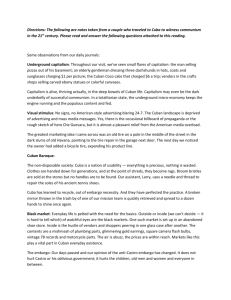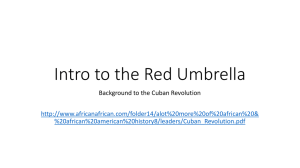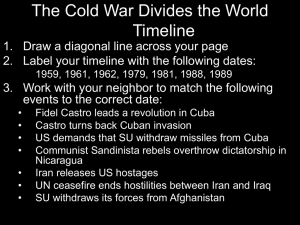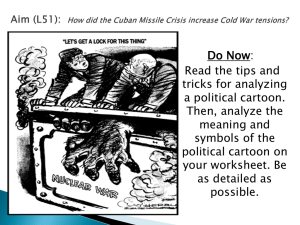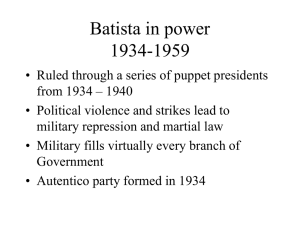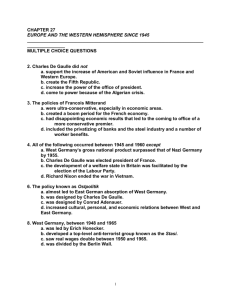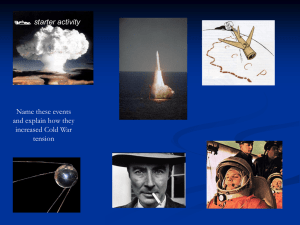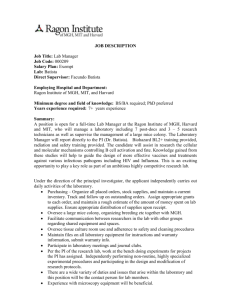Violations of Freedom of the Press in Cuba: 1952–1969
advertisement
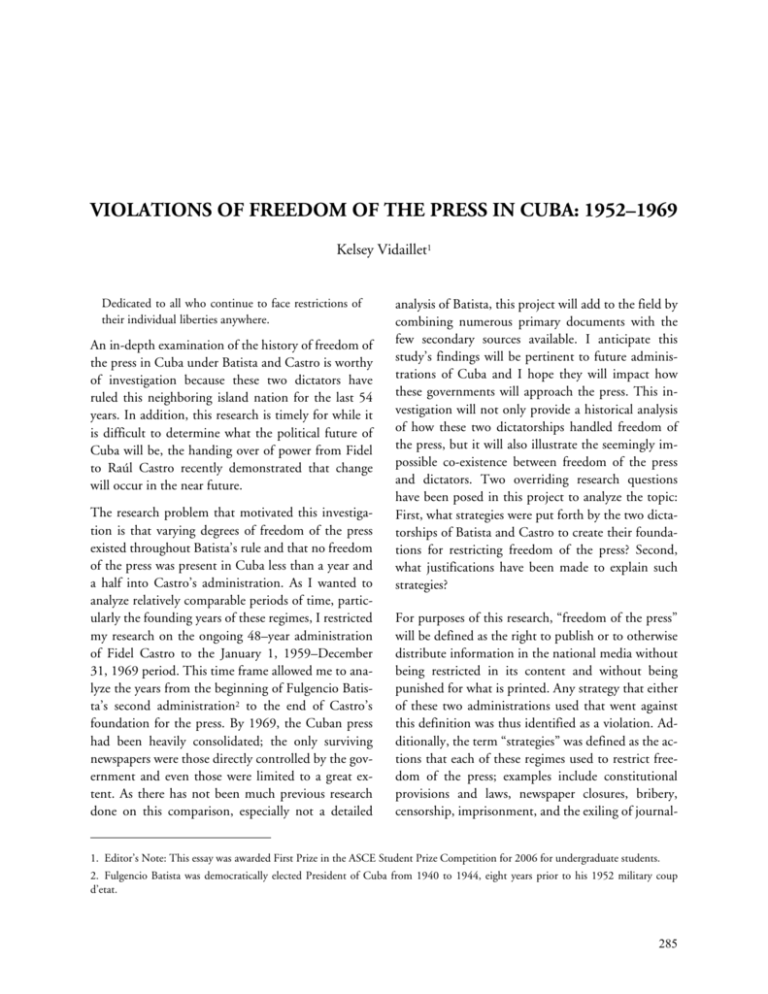
VIOLATIONS OF FREEDOM OF THE PRESS IN CUBA: 1952–1969 Kelsey Vidaillet1 Dedicated to all who continue to face restrictions of their individual liberties anywhere. An in-depth examination of the history of freedom of the press in Cuba under Batista and Castro is worthy of investigation because these two dictators have ruled this neighboring island nation for the last 54 years. In addition, this research is timely for while it is difficult to determine what the political future of Cuba will be, the handing over of power from Fidel to Raúl Castro recently demonstrated that change will occur in the near future. The research problem that motivated this investigation is that varying degrees of freedom of the press existed throughout Batista’s rule and that no freedom of the press was present in Cuba less than a year and a half into Castro’s administration. As I wanted to analyze relatively comparable periods of time, particularly the founding years of these regimes, I restricted my research on the ongoing 48–year administration of Fidel Castro to the January 1, 1959–December 31, 1969 period. This time frame allowed me to analyze the years from the beginning of Fulgencio Batista’s second administration2 to the end of Castro’s foundation for the press. By 1969, the Cuban press had been heavily consolidated; the only surviving newspapers were those directly controlled by the government and even those were limited to a great extent. As there has not been much previous research done on this comparison, especially not a detailed analysis of Batista, this project will add to the field by combining numerous primary documents with the few secondary sources available. I anticipate this study’s findings will be pertinent to future administrations of Cuba and I hope they will impact how these governments will approach the press. This investigation will not only provide a historical analysis of how these two dictatorships handled freedom of the press, but it will also illustrate the seemingly impossible co-existence between freedom of the press and dictators. Two overriding research questions have been posed in this project to analyze the topic: First, what strategies were put forth by the two dictatorships of Batista and Castro to create their foundations for restricting freedom of the press? Second, what justifications have been made to explain such strategies? For purposes of this research, “freedom of the press” will be defined as the right to publish or to otherwise distribute information in the national media without being restricted in its content and without being punished for what is printed. Any strategy that either of these two administrations used that went against this definition was thus identified as a violation. Additionally, the term “strategies” was defined as the actions that each of these regimes used to restrict freedom of the press; examples include constitutional provisions and laws, newspaper closures, bribery, censorship, imprisonment, and the exiling of journal- 1. Editor’s Note: This essay was awarded First Prize in the ASCE Student Prize Competition for 2006 for undergraduate students. 2. Fulgencio Batista was democratically elected President of Cuba from 1940 to 1944, eight years prior to his 1952 military coup d’etat. 285 Cuba in Transition · ASCE 2006 ists. The overall structure of this paper is to describe the circumstances surrounding the ascent to power of each of these dictatorships and the tactics each used with regard to freedom of the press. ANALYSIS/INTERPRETATION Fulgencio Batista: 1952–1958 On March 10, 1952, General Fulgencio Batista3 took advantage of the political corruption that was taking place under the previous administration of Carlos Prío Socarrás to lead a military coup d’etat. This occurred only a few weeks prior to the 1952 elections, in which Batista—who was a Presidential candidate—was expected to lose. For ousting the corrupt Prío government and promising to establish law and order, Batista initially enjoyed support at least among a minority of the population. In general, varying degrees of freedom of the press existed throughout Batista’s rule. To win over the press to report favorably, he relied on an incentive policy of bribes and inducements. As the strength of the opposition to his regimen grew, he suspended constitutional protections to suppress the press. Immediately following his coup d’etat, General Batista enforced a “news dim out,” according to the Editor & Publisher journal. Five days after he came to power, the journal stated, “police and army units were dispatched to all radio and television stations throughout Havana,” and “announcers were prohibited from mentioning the overthrow of the [Prío] government at the threat of gunpoint.” Two Havana morning dailies, Alerta and El Crisol, were given permission to publish the story.4 They were given an “exclusive beat” because they published the story before the “news dim out” went into effect. Another strategy that Batista used to restrict the press immediately upon taking office was the promise that he would not tolerate the printing of “inflammatory material” against his regime. In order to control the printed press more effectively, Batista established the Ministry of Propaganda (later renamed the Ministry of Information) “to issue regular government news releases.”5 To lead this office, Batista appointed Ernesto de la Fé, a relatively unknown newsman.6 In this early period, the Batista government made its requests known of what would and would not be permitted in the press “by a friendly sort of subtle censorship.”7 According to Editor & Publisher, these subtle desires would be made clear by a phone call from the Ministry of Propaganda which would “request…that a certain news item not be published, or that it be played strong, depending on the government’s viewpoint.”8 Perhaps this subtlety is best described in a quote by an anonymous newspaper publisher in Havana at the time: The government has not told us what we can, or cannot, print. Everything, thus far, has been on a Moe to Joe basis. We will get a telephone call from the Palace asking us if we would please do this or that. Naturally, we comply because we don’t know what will happen if we don’t.9 While initially Batista attempted to control the press through subtle gestures, his strategy changed within two months to one of trying to “win the press over.”10 The regime did this in two predominant ways. First, Batista replaced Congress by creating a Consultative Council that would recommend legislation to the Cabinet, which could then be made into law. Out of the 80 members of the council, Batista 3. At the time, Batista was a member of the Cuban National Senate, having been elected in 1948. 4. D. D. Bonafede. “Batista Coup News Silenced At Gunpoint,” Editor & Publisher, 15 March 1952, 14. 5. John A. Lent. “Five Historical Stages of Cuban Mass Media: 1723–1983,” Studies in Latin American Popular Culture, vol. 8 (1989), 257. 6. “Subtle Control Exercised Over Press in Cuba,” Editor & Publisher, 22 March 1952, 8. 7. Ibid. 8. Ibid. 9. “Subtle Control Exercised Over Press in Cuba,” Editor & Publisher, 22 March 1952, 8. 10. “Batista Softens His Attitude Toward Press,” Editor & Publisher, 17 May 1952, 34. 286 Violations of Freedom of the Press in Cuba: 1952-1969 appointed 10 individuals from various newspapers. Second, Batista ordered the proceeds from two national lotteries to go directly to the Association of Reporters. It is estimated that the total amount from each of these lotteries was over $25,000.11 In short, Batista purposely placed members of the press in toplevel advisory positions and directed lottery funds to ensure the goodwill of the press at large. In August 1952, the Batista government temporarily closed the newspaper La Calle after it published two editions.12 From this time until July 1953, there was relatively little censorship in Cuba. However, in October 1952, the Inter-American Press Association (IAPA) held a meeting in Mexico City, at which Cuba was included on the list of countries that limited freedom of the press “in one way or another.” Interestingly, however, Cuban editors and other individuals suffering from censorship in other countries were invited to the IAPA meeting to “speak freely to a sympathetic audience which was pledged to help them in their struggle for freedom of the press.”13 These Cuban editors had to receive permission from the Cuban government to attend this meeting. One week later, a New York Times article claimed that Batista held no hard feelings against those editors who went to Mexico City.14 This somewhat subdued period in the relationship between the Batista government and the press was short-lived. Although Batista had previously enjoyed support—even if only from a minority of the population—an opposition of mostly lower middle or working class15 persons soon appeared. On Sunday July 26, 1953, a group led by a former student leader at the University of Havana, Fidel Castro, attacked the Moncada military barracks. Immediately following this armed assault, Batista suspended all constitutional guarantees.16 Additionally, the government imposed censorship on four publications “considered to reflect the opinions of the opposition,” and on July 28 the censorship was extended to all newspapers and magazines in Cuba.17 In response to these events, the IAPA sent a letter to President Batista denouncing these measures and urged him to revoke such censorship.18 Not only was this request ignored, but Batista—in an attempt to prevent possible future revolts against his government—also established Decree Law 997 on Public Order on August 6, 1953.19 This law provided for “fines, prison sentences and the closing of businesses for those guilty of ‘damaging the dignity of the nation,’ harming its economy or expressing disrespect for the Government, its officials or organs.”20 At his trial in September 1953, Castro, a lawyer, represented himself and articulated the rationale for attacking the Moncada. This speech, which later came to be known as La historia me absolverá or “History will absolve me,” was published as a pamphlet. Castro claimed that the attack occurred to achieve four main objectives. First, had the Moncada been successful, the rebels would have restored the 1940 Constitution that Batista had suspended intermittently throughout his regime. Second, they would have led an agrarian reform. Third, they would have implemented a profit-sharing plan for workers and employers of the sugar mills. Fourth, Castro claimed 11. Ibid 12. “Anti-Batista Daily Back in Business,” Editor & Publisher, 30 April 1955, 124. 13. “Inter-American Press,” The New York Times, 14 October 1953, 28. 14. Herbert L. Matthews, “Batista Promises Presidential Vote,” The New York Times, 17 October 1953, 5. 15. Hugh Thomas, The Cuban Revolution (New York: Harper & Row, 1977), 38. 16. The New York Times, 29 July 1953, 6. 17. Ibid. 18. Ibid. 19. Sydney Gruson, “10 Latin Countries Called Press Foes,” The New York Times, 10 October 1953, p. 6. 20. “Cuban Censorship Lifted by Batista,” The New York Times, 25 October 1953, 31. 287 Cuba in Transition · ASCE 2006 that “all land illegally obtained and all other property or cash obtained by fraud would [have been] confiscated.”21 The suspension of constitutional guarantees that was put into effect immediately following the July 26 revolt was set to end on October 28.22 Yet, arguably in an effort to appeal both the people and the press, Batista’s government officially ended the suspension four days earlier, on October 24.23 It should be noted, however, that Decree Law 997 on Public Order went unchanged. In addition to the laws implemented and the Constitutional suspension, it is interesting to examine what President Batista specifically said in regard to freedom of the press: Censorship is as distasteful to me as it is to any other person who believes in a democratic system of government…I am fully conscious of the fact that censorship is extremely unpopular. … It is my honest belief that the only time censorship is justified is when national security is threatened by the lack of it. … I give my assurance that censorship was applied in Cuba as a temporary emergency measure. … My Government has never at any time given the slightest thought to censorship as a permanent measure. The dangers of permanent restrictions on the basic freedoms of democracy are as remote in Cuba as they are in the United States.24 With these words, Batista makes an argument similar to that invoked by legitimately elected governments during times of crisis even to this day. His language is reminiscent of that used by proponent of the Patriot Act in the U.S. Congress soon after the September 11, 2001 terrorist attacks. In Cuba, following the July 26, 1953 Moncada attack, those found guilty were sentenced to a maximum of fifteen years. However, less than two years later, on May 15, 1955, Batista granted amnesty to all political prisoners and the attackers were subsequently released. This occurred both because of the increased pressure of government critics and because Batista did not feel seriously threatened by the insurgents.25 It is crucial to note that following his release, Fidel Castro went to Mexico to once again plan future attacks against the Batista administration. Between September 1953 and May 1955, when the rebels were imprisoned, Batista felt confident that his government could withstand any opposition and thus approached the press in a more amicable manner. During this time, any potential opponents to the government learned to censor themselves in response to the previous repression that had occurred. Such a finding is supported by a March 1954 New York Times article, claiming that the Cuban press was “free.” The article further clarified, however, that this freedom is one where “there is individual surveillance and limitation,” and that although “the press is free to publish what it chooses, a visitor gets the impression that it is wary in practicing that privilege.”26 Although there was no official censorship, there were still limitations on freedom of the press through selfimposed restrictions. Despite any possible self-censorship and in praise of Batista’s overall favorable treatment of the press, the IAPA named Cuba to be free of press censorship in both 1955 and 1956.27 There is one striking exception to Cuba’s so-called press censorship during this period, the second closing of La Calle in July 1955, after only ten weeks of publication.28 Two and a half years after its first clos- 21. Hugh Thomas, The Cuban Revolution (New York: Harper & Row, 1977), 44. 22. Herbert L. Matthews, “Batista Promises Presidential Vote,” The New York Times, 17 October 1953, 5. 23. “Cuban Censorship Lifted by Batista,” The New York Times, 25 October 1953, 31. 24. Herbert L. Matthews, “Batista Promises Presidential Vote,” The New York Times, 17 October 1953, 5. 25. Hugh Thomas, The Cuban Revolution (New York: Harper & Row, 1977), 77. 26. Arthur Krock, “In the Nation,” The New York Times, 23 March 1954, 26. 27. Marvin Alisky, “Cuban Press: Censorship Replaces Bribery,” Nieman Reports (April 1957), 17. 28. Jay Mallin, “Cuban Police Seal Plant of Insolent Daily,” Editor & Publisher, 2 July 1955, 48. 288 Violations of Freedom of the Press in Cuba: 1952-1969 ing, the government justified its actions because of the newspaper’s “insolent and virulent expression.”29 According to Editor & Publisher, “the government charged that La Calle had ‘systematically adultered the truth’ in attempting to ‘incite to violence, disrupting civil harmony, damaging the prestige of state institutions and insulting authorities and functionaries.’”30 Such a claim is supported by Miriam Rodríguez Betancourt, a Professor of Journalism at the University of Havana, who states that Fidel Castro published articles in La Calle that “bitterly attacked the [Batista] dictatorship, corruption, and the degeneracy of the regime.”31 Furthermore, Batista’s government had not only claimed that there were communists on the staff of La Calle and that they were using “communists tactics” in attacking the government, but it also stated that the owner, José B. del Cueto, had received $30,000 from ex-President Carlos Prío Socarrás “to acquire a printing press for the paper.”32 Regardless of the stated rationalization, the fact remains that these actions demonstrate overt press censorship even during an overall censorship-free period. On April 30, 1956, there was another armed, guerrilla attack in the city of Matanzas.33 Following the attack, Batista once again suspended all constitutional guarantees, including freedom of the press. Although the censorship was to stay in effect until June 13, General Batista “instructed the Minister of Interior to lift censorship restrictions immediately” on June 2, 1956.34 Such an apparent easing of press restrictions was clearly nothing more than an attempt to give the appearance that the government was supportive of freedom of the press, while in fact, it maintained its policy of censorship. In general, I agree with Professor Carlos Ripoll’s35 statement that constitutional guarantees were largely suspended from the arrival of Fidel Castro on December 2, 1956, from Mexico to Batista’s flight from Cuba on December 31, 1958. In the two months following Castro’s landing in Oriente Province in Cuba, the Batista regime switched “from the big carrot to the big stick, from widespread bribery to overt censorship of the press,”36 according to Marvin Alisky. On January 15, 1957, Batista “proclaimed a state of siege”37 in response to guerrilla fighting in eastern Cuba, and once again imposed press censorship. In addition to censorship of the press printed within the Island, the Batista government also placed restrictions on the domestic circulation of foreign news that contained information about Fidel Castro and the rebels; two newspapers affected were The New York Times and the Miami Herald. On February 18, the IAPA demonstrated their disapproval of such violations of freedom of the press in calling for the “immediate lifting of the unjustified censorship” on these two foreign newspapers.38 29. “Anti-Batista Daily Back in Business,” Editor & Publisher, 30 April 1955, 124. 30. Mallin, “Cuban Police Seal Plant of Insolent Daily. 31. Miriam Rodriguez Betancourt, “Cuban Media Yesterday and Today,” The Democratic Journalist, Issue 12 (1980), 19. 32. Ibid. 33. “Cuban Press Curb Off,” The New York Times, 4 June 1956, 19. 34. “Cuban Censorship Ends,” The New York Times, 3 June 1956, 16. 35. Carlos Ripoll is a Cuban-American, who was a former Professor of Romance Languages at Queens College. Carlos Ripoll, Harnessing the Intellectuals: Censoring Writers and Artists in Today’s Cuba (Washington, D.C.: Cuban-American National Foundation, 1985), 12. 36. Marvin Alisky is a former Assistant Professor of Journalism and Television at Indiana University. Marvin Alisky, “Cuban Press: Censorship Replaces Bribery,” Nieman Reports (April 1957): 17. 37. Ibid. 38. “Protest Sent to Cuba,” The New York Times, 20 February 1957, 22. 289 Cuba in Transition · ASCE 2006 Although the censorship that began on January 15 was scheduled to end on March 2, the government remained consistent in their previous actions by officially ending it a few days early, on February 26.39 According to Batista’s Minister of the Interior, the lifting of censorship prior to the expiration was “evidence of the feelings and desires of the Chief of State [President Fulgencio Batista] and his severe devotion to the liberty of the press and freedom of expression.”40 This action is yet another example of the unimaginative rhetoric used by Batista and his government officials to cover what the Cuban people and the international press knew represented to be blatant violations of freedom of the press. The key issue that was censored from the news in the printed press was the extent of the fighting that was going on in eastern Cuba. According to The New York Times, the police would have to cut out or black out articles from foreign publications that “referred to revolutionary or terroristic activities in Cuba.”41 This is not to say, however, that citizens in other parts of Cuba were not aware of the widespread opposition to the Batista government. Using another form of media, the guerrillas in eastern Cuba broadcasted a nightly radio show on Radio Rebelde. Through these radio broadcasts, Cuban citizens around the Island became aware of the fighting and growing opposition to Batista. Fulgencio Batista once again suspended constitutional guarantees on August 1, 1957.42 Consequently, in September 1957, the IAPA denounced these violations of freedom of the press. In fact, the IAPA Executive Committee declared Cuba to be “undemocratic” because of its disrespect for freedom of the press.43 Although the forty-five day suspension that was put into place on August 1, 1957 was to have ended on September 15, General Batista placed an additional suspension on all constitutional guarantees on September 14 for another forty-three day period.44 The precise duration of any given period of constitutional suspension is irrelevant since the government had a long established track record of violations to fit their needs to control the press and others. There was nothing benevolent about their early termination in the previous occurrences for on those occasions, the suspensions were simply reinstituted when needed. Batista’s extension of the sanctions beyond the initially-determined number of days suggests that he no longer felt the need to play the game by the earlier rules. Similar to the Cuban editors who were permitted to attend the IAPA’s meeting in Mexico City in October 1952, other editors attended the IAPA’s meeting in Buenos Aires, Argentina, in October 1958. While in Argentina, two of these Cuban editors, Guillermo Martínez Márquez, the former President of the IAPA and director-on-leave of the newspaper El País and Jorge Quintana, director of the magazine Bohemia, spoke out against the violations of freedom of the press on the Island. They complained “that the Cuban press was undergoing the worst censorship they had yet experienced,” and they asked for “the ‘strongest possible’ condemnation of press restrictions under the Batista government.”45 Ultimately, in response to growing internal opposition, Batista left Cuba on December 31, 1958, for the Dominican Republic. 39. Alisky, “Cuban Press: Censorship Replaces Bribery.” 40. “Censorship Ends Today, Cuba Says,” The New York Times, 26 February 1957, 12. (It should be clarified that this article states that the expiration is March 1 and not March 2.) 41. Ibid. 42. “Freedom of the Press,” The New York Times, 11 August 1957, 148. 43. “The Cuban Censorship,” The New York Times, 11 September 1957, 32. 44. “Cubans Protest Press Curb,” The New York Times, 9 October 1957, 8. (It should be noted, however, that from September 14, 1957 to December 31, 1958, I was unable to locate newspaper articles that addressed whether constitutional guarantees were suspended or not during this period.) 45. “Censorship Held Extreme,” The New York Times, 5 October 1958, 32. 290 Violations of Freedom of the Press in Cuba: 1952-1969 Based on this research, I have reached the following conclusions about Batista’s approach to the press.On the one hand, it is clear that Batista largely relied on an incentive policy to win the press over. From the very beginning he appointed prominent journalists of his liking to his Consultative Council where they were to serve as advisors. Additionally, Batista showed preferential treatment to the press when he ordered the proceeds from two national lotteries, totaled at approximately $100,000, to go the Association of Reporters. Finally, Batista also bribed certain journalists to report favorably about his government. Some have argued that by the end of 1958, Batista was paying the press up to $450,000 a month in subsidies. Possibly because he provided incentives to the press, Batista may not have felt the need to confiscate any newspapers or imprison any journalists. On the other hand, Batista was successful in using a “stick” policy when he felt it necessary. First, he closed two major national newspapers, La Calle in August 1952 and July 1955 and Noticias de Hoy in 1953. Batista also suspended the Constitution when there was a perceived threat to his government. In the area of constitutional provisions and laws, Batista temporarily suspended constitutional guarantees— including freedom of the press—on 5 separate occasions, for a total of 255 days. There were actually relatively few suspensions in Batista’s early years, but in 1957 and 1958 pressure from a growing opposition prompted additional suspensions. Lastly, Batista established Decree Law 997 on Public Order in August 1953 in response to the July 26, 1953, armed rebellion led by Fidel Castro. This decree permitted the government to impose fines, prison sentences, and the closing of businesses for those thought to be guilty of “damaging the dignity of the nation,” its economy or being disrespectful to the Government of its officials.46 Batista’s strategies were largely influenced by the growing opposition to his government. Fidel Castro: 1959–1969 Possibly because he benefited from Batista’s periods of leniency with the press and clemency with armed guerilla fighters that opposed him, Castro never tolerated dissent of any kind. Not only did he censor the press, he managed to exert complete control of all printed media in the island through the use of closures and confiscations of newspapers and imprisonment and exiling of journalists. For all practical purposes, he had achieved these objectives within 18 months of his ascent to power. While leading the rebellion against the Batista dictatorship, Fidel Castro and his group of rebels illegally published newspapers, such as Sierra Maestra and El Cubano Libre,47 that supported their revolutionary ideas. As with other potential adversaries and many of his initial supporters, Castro misled the press. He issued his “First Manifesto” from the Sierra Maestra Mountains on July 12, 1957; this manifesto was later published by the magazine Bohemia in direct defiance of Batista. In the “Manifesto,” Castro declared that the provisional government, which would be established after the successful revolution, would rest on “absolute guarantee of freedom of information, of the spoken and written press and of all the individual and political rights guaranteed by the constitution [of 1940].”48 Following the flight of Fulgencio Batista in December 1958 and his subsequent ascension into power, Castro addressed the United Nations in January 1959. He promised that Cuba would maintain a free press, as well as become democratic.49 However, as illustrated in what follows, such guarantees seemed not to play an important role in Cuba’s near future. Castro demonstrated his desire to be the sole voice behind his government from the very beginning. He eliminated the risk of having potential disagreements with his policies by the printed press by having no intermediaries. Castro alluded to his future treatment of the press when in early 1959 he claimed that he 46. “Cuban Censorship Lifted by Batista,” The New York Times, 25 October 1953, 31. 47. Rodríguez Betancourt, “Cuban Media Yesterday and Today,” 19. 48. Jerry Redding, “‘Castro-ating’ the Media,” Educational Broadcasting Review, vol.5, no.3 (June 1971), 35. 49. James W. Carty, Jr., “Difficult to Get Visas: Castro Prefers Foreign Journalists,” The Times of the Americas. 4 October 1978, 16. 291 Cuba in Transition · ASCE 2006 had little use for the written press, for “when he wanted to talk to the people, he would do so by having his words broadcast to every village”50 via television and radio. Castro soon took full advantage of the media, with numerous and lengthy speeches up to several hours in duration that were first transmitted over television and radio and later printed in full in the newspapers. According to political scientist, Jorge I. Domínguez, “in 1959, he [Castro] made a public statement—speeches of considerable length—almost every other day. Between 1960 and 1962, he made a public statement two or three times every ten days.”51 It seemed that at the beginning of his regime, Castro enjoyed the support of the majority of editors and publishers, who were largely opposed to the censorship and policies that had taken place under Batista; but disagreement soon became more prevalent. This occurred as Castro began criticizing specific newspapers in his regular television appearances. Castro threatened the “mildly-outspoken papers”52 Prensa Libre, Diario de la Marina, and Avance by claiming that these papers “would be killed with anemia through a boycott of their advertisers.”53 Such a threat was followed by Castro’s immediate response to stop all press subsidies, except those to his regime’s newspaper, Revolución. In addition to threats, the revolutionary dictatorship soon proclaimed that anyone who acted against the government (by such actions as meeting in small groups, attempting to contact friends in the United States, or conspiring to leave the country) was a counter-revolutionary. Consequently, the press began to condemn the Castro government to a greater extent. As the newspapers Prensa Libre, Diario de la Marina, and Avance continued to demonstrate their disapproval of the Castro regime throughout 1959, the Cuban government became more dependent on their paper Revolución as well as the Communist paper Hoy54 to transmit the goals of the revolution. On January 29, 1959, Revolución published what it claimed to be a list of newspapers and journalists who regularly received bribes from the Batista regime. Based on that article, individual journalists were said to have received anywhere from $500 to $16,000 in bribes on a monthly basis.55 Hugh Thomas has argued that by the end of 1958, Batista was paying the press up to $450,000 a month in subsidies.56 According to Revolución’s list, “only three news organizations [during Batista times] refused to accept subsidies: the Times of Havana, Prensa Libre, and the magazine Bohemia.”57 In response to the publication of this list and in an attempt to justify confiscation of independentlyowned newspapers, the Castro regime established the Fundamental Law of 1959 only five weeks after coming to power on February 7, 1959.58 For all practical purposes, this law served as the Constitution of Cuba until the official one was created in 1976. Article 24 permitted the Ministry of Recovery of Stolen Property to confiscate the belongings of industries and individuals who had accepted gifts, favors, and subsidies from the Batista government.59 Through the passing of this law, it became confirmed that Castro would 50. R. Hart Phillips, “Castro Reaches 95% of Cubans With Radio-TV Exhortations,” The New York Times, 6 August 1959, 9. 51. Jorge I. Domínguez, Cuba: Order and Revolution (Cambridge, Massachusetts: The Belknap Press of Harvard University Press, 1978), 197. 52. Lent, “Five Historical Stages of Cuban Mass Media: 1723–1983,” 260. 53. Ibid. 54. Hugh Thomas, Cuba: The pursuit of freedom (New York: Da Capo Press, 1998), 1261. 55. Michael B. Salwen, “The Dark Side of Cuban Journalism: Press Freedom and Corruption before Castro,” in Communication in Latin America: Journalism, Mass Media and Society, ed. Richard R. Cole (Wilmington, DE: Scholarly Resources, 1996), 143. 56. Thomas, Cuba: The pursuit of freedom, 1136. 57. Salwen, “The Dark Side of Cuban Journalism: Press Freedom and Corruption before Castro,” 143. 58. Ripoll, Harnessing the Intellectuals, 12. 59. Salwen, “The Dark Side of Cuban Journalism,” 144. 292 Violations of Freedom of the Press in Cuba: 1952-1969 eliminate any opposition to his regime “through expropriation, discontinuance of subsidies, withholding of government advertising, and encouraging independent advertisers to do the same.”60 During that same month, Castro expropriated the newspapers Alerta, Mañana, Tiempo, Ataja, and Pueblo. The newspaper production facilities of Alerta were converted into Revolución,61 the official voice of the Castro regime; the other four papers were converted into the government organs Noticias de Hoy, La Calle, Combate, and Diario Libre.62 The government used the Fundamental Law to justify these five takeovers, claiming that these newspapers had received subsidies from former dictator, Fulgencio Batista. Two such allegations are perhaps not completely unfounded. According to Dr. Michael Salwen, an associate professor in the School of Communication at the University of Miami, the newspaper Alerta was operated by Batista’s minister of communications, Ramón Vasconcelos.63 Hugh Thomas has also argued that Pueblo was personally owned by Fulgencio Batista.64 In spite of the already present turmoil in the Cuban press, Castro gave a television interview on April 2, 1959, in which he said: To persecute the Catholic because he is Catholic, to persecute the Protestant because he is Protestant, to persecute the Mason because he is Mason, to persecute the Rotarian because he is Rotarian, to persecute La Marina (morning newspaper) because it may be a newspaper with a rightist tendency, or to persecute another because it has a leftist tendency, one because it is radical and of the extreme right or the other of the extreme left, I cannot conceive of, nor will the Revolution. … We are doing what is democratic; respecting all ideas. When one begins by closing a newspaper, no newspaper can feel secure; when one begins to persecute a man for his political ideas, nobody can feel secure.65 As much as any other of his quotes, this statement demonstrates that Castro truly wanted to appear to be tolerant of political dissent and supportive of freedom of the press. In reality however, this was not the case and his actions always spoke louder and would resonate longer than any of his interminable speeches. In the international arena for example, Castro attended the American Society of Newspaper Editors meeting in Washington, D.C. in April 1959. During his speech on April 17, Castro denounced dictators and again spoke favorably of a free press.66 Nevertheless, both of these speeches quickly seemed a mere smokescreen because that same month, Juan Luis Martín, a respected columnist from the newspaper El Mundo was arrested and held incommunicado for two weeks. He was released without explanation and was not charged with an offense. Despite this event, only one newspaper in Cuba wrote about the incident.67 Beginning in mid-1959, the Castro regime took the view that egalitarian goals could override press independence and justified new press taxes. According to The New York Times on June 2, 1959, Castro’s regime proposed a law to tax individuals mentioned in society news: under the proposed law, the mention of one’s name on a society page would cost a person $1—or $100 if one has a title of nobility, plus $1 for every adjective describing the person. A photograph would cost $5 a column inch or, if more than one person is in the photograph, $10 an inch. The newspapers would 60. Black, Area Handbook for Cuba, 319. 61. Salwen, “The Dark Side of Cuban Journalism,” 142. 62. Black, Area Handbook for Cuba, 319. 63. Salwen, “The Dark Side of Cuban Journalism,” 142. 64. Thomas, Cuba: The pursuit of freedom, 1136. 65. Ripoll, Harnessing the Intellectuals, 14 (emphasis mine) 66. Marvin Alisky, “Confused Cuba: Printers Who Edit—Government by Television,” Nieman Reports. (April 1960), 13. 67. “Only the Times of Havana…carried a one-column description of the arrest.” See Salwen, “The Dark Side of Cuban Journalism,” 143. 293 Cuba in Transition · ASCE 2006 have to collect the tax and could retain 10 per cent for their trouble.68 In an attempt to create a class-less society, Castro wanted to rid the printed press of any mention of the parties and social gatherings of the elite classes in Cuba. Due to great protests within the island, however, The New York Times wrote four days later, the proposed tax would be withdrawn from legislation.69 While the government claimed that “such a tax would greatly benefit the newspapers, since they would collect hundreds of thousands of dollars,” the newspapers were largely unsupportive of the new tax. In fact, an editorial in the Diario de la Marina claimed that the tax was “an attempt of aggression against freedom of speech.”70 As a new strategy, the Castro regime used the media selectively, favoring both radio and television in relation to the printed press. In August 1959, another New York Times article claimed that only seven months into Castro’s administration, newspaper readership had sharply declined in Cuba.71 In speculating on the causes for this trend, the author suggested two likely causes. Part of the reason lay in the seemingly contradictory information given to the printed press by the government.”? For while Castro talked of trying to help the press, “he has (also) said that there are too many newspapers and magazines and too many reporters.”72 Additionally, a second cause of readership decline might also be due to the fact that “there is little criticism of the regime’s policies. When any criticism is voiced, Dr. Castro de- nounces the critics during his radio-TV appearances.”73 Due to such denunciations of the private press by the government, the only newspapers that were doing well in Cuba, according to this article, were those “that are regarded as ‘voices’ of the Government.”74 On December 26, 1959, the Provincial Association of Journalists of Havana proposed ordering all newspapers to include footnotes for any editorials or news perceived to be against the government.75 The appendages read: “This news item is being published by order of this journalistic enterprise exercising the legitimate right of freedom of the press that exists in Cuba, but the journalists and printshop worker of this work place also exercise the same right by saying that it does not correspond to the truth or to the most elemental ethics of journalism.”76 Such footnotes came to be known as coletillas (tails). The proposal went into effect on January 4, 1960, and the first coletillas began to appear on January 17.77 Essentially, the disclaimer was used, according to the journal Editor & Publisher, “to prove that Cuba has a free press but that the unions, also in the exercise of ‘freedom of the press’ declare that the article is factually incorrect, is a violation of journalistic ethics, an attack, and forms a part of a plot against the Cuban revolution.”78 Such a measure was perhaps necessary for the Castro regime in order to establish the boundaries that the printed press would have under his government. According to Alisky, 68. R. Hart Phillips, “Society-News Tax? Cuban Editors Shocked,” The New York Times, 2 June 1959, 16. 69. R. Hart Phillips, “Society News Tax Is Dropped in Cuba,” The New York Times, 6 June 1959, 1. 70. R. Hart Phillips, “Society-News Tax?,” 16. 71. R. Hart Phillips, “Castro Methods Hurt Cuba Press,” The New York Times, 24 August 1959, 8. 72. Ibid. 73. Ibid. 74. Ibid. 75. Ripoll, Harnessing the Intellectuals, 14. 76. Baldomero Alvarez Ríos, “The ‘Appendage’: A Historic Measure of Cuban Journalism,” Granma, 3 November 1985, 2. 77. Ibid. 78. Robert U. Brown, “IAPA Urges Castigation of Cuba’s Press Seizure: Resolutions of Board Also Cite Bolivia, Dominica and Paraguay,” Editor & Publisher, 26 March 1960, 10 294 Violations of Freedom of the Press in Cuba: 1952-1969 other than control of the armed forces, no factor is more essential to an authoritarian government than mass media control. Marxist ideology warns that the media cannot function outside the society from which they spring, and in a Communist state, the media serve the government and the party, their primary function is not the factual reporting of news.”79 In disagreement with the coletillas, both Diario de la Marina and Información appealed to the Supreme Court to challenge the government’s actions. Nevertheless, their “petition was rejected on procedural grounds.”80 However, one of the magistrates, Miguel Márquez y de la Cerra, issued a dissenting opinion: In my view the measure taken … with respect to the editorial opinions of newspapers, represents a moral damage … because it is or could be a limitation on the free expression of thought. 81 I agree with Magistrate Miguel Márquez y de la Cerra in that the coletillas were used by the Castro regime as a tool to curtail freedom of the press, not as means of promoting it. This became clear soon for when the Cuban government became the sole owner of newspapers. When that happened, newspaper employees with opinions that differed from the government views were not allowed to publish coletillas as their counterparts had been able to do when they disagreed with the news coverage or editorials in independently-owned newspapers. In fact, the day after the coletillas made their first appearance in the Cuban press, the confiscation of the remaining independent press in Cuba began. It started when the publisher of Avance, Jorge Zayas, “wrote an article critical of his newsroom employees who, without his permission, had attached disapproving statements to some local and foreign wire service stories in the newspaper that they regarded as critical of Castro and the Cuban government.”82 Zayas responded in yet another editorial, alerting his readers that the “messages reflected the views of disgruntled employees and should be ignored.”83 In subsequent publications, the employees of Avance and Zayas himself participated in a heated debate in the paper over who had the right to exercise “freedom of the press.”84 Zayas, who must have been fearing for his safety, had already arranged for his family to be sent to the United States;85 and shortly after the divisive quarrel with some of his employees, Zayas sought asylum in the Embassy of Ecuador.86 While Zayas was still at the embassy, Castro delivered a fivehour speech in which he attacked both Zayas and Avance for nearly two hours. In this speech, Castro proclaimed: Freedom of the press is not what he (Zayas) thinks it is. Freedom of the press is not freedom to sell oneself to the highest bidder, as he has done with his newspaper. …The professional class of the press needs get rid of the shameful burden of the criminals and embezzlers of public funds, and then it can count on the backing of all (Cubans).87 Out of fear of even harsher attacks, Zayas fled to exile in Florida on January 20, 1960—only two days after the Avance dispute began.88 After the confiscation of Avance, other publications such as El Crisol, Excelsior, and El Mundo were either closed or taken over by the government. The Castro regime justified its actions by claiming that these 79. Marvin Alisky, Latin American Media: Guidance and Censorship (Ames: Iowa State University Press, 1981), 155 (emphasis mine). 80. Ripoll, Harnessing the Intellectuals, 14. 81. Ibid. 82. Salwen, “The Dark Side of Cuban Journalism,” 145. 83. Ibid. 84. Ibid. 85. Thomas, Cuba: The pursuit of freedom, 1261. 86. Ibid. 87. Salwen, “The Dark Side of Cuban Journalism,” 145. 88. Marvin Alisky, “Confused Cuba: Printers Who Edit—Government by Television,” Nieman Reports (April 1960), 12. 295 Cuba in Transition · ASCE 2006 three newspapers had links to the Batista administration.89 Unlike Avance’s Jorge Zayas, however, the editor of El Crisol, Alfredo Izaguirre, did not seek asylum or leave the country and was subsequently sentenced to a 40–year prison term. In 1979, he was released after having served 18 years.90 El Mundo was taken over by the government on either January 22 91 or February 23, 1960,92 depending on the source. After the newspaper was confiscated, the owner, Amadeo Barletta, sought asylum in the Italian Embassy.93 There are three slightly different justifications for why the newspaper El País was closed. Thomas speculated that El País collapsed “after its editor, Guillermo Martínez Márquez—one of the editors who had attended an IAPA meeting during the Batista regime—resigned after refusing to print a coletilla at the foot of an anti-Communist article.”94 Yet, Professor Ripoll states that “economic strangulation was used when … its clients, industries and businesses, pressured by official elements, withdrew their advertisements.”95 The final potential explanation claims that “a labor conflict between the owners of El País and Excelsior and their workers culminated in Castro’s suggestion that the newspapers merge with others whose owners had left the country.”96 Whatever the exact cause of the paper’s closing, Journalist Luis Rodríguez Rodríguez, who worked for El País, was sentenced to a 30 year jail sentence in 1962 after being accused of collaborating with anti-government forces. In the mid-1980s, he received five more years for an “additional infraction.” He was released from prison on November 20, 1989, and arrived in Miami the next day.97 “The actions in Cuba against the freedom of the press, against the seizure and confiscation of the private property of publications, and against the free exercise of the journalistic profession,”98 denounced the IAPA according to a March 1960 article in Editor & Publisher. By April 1960, a little over a year into Castro’s regime, the seventeen Havana independent daily newspaper thriving in January 1959 had dwindled down to four.99 They were El Crisol, Información, Diario de la Marina, and Prensa Libre. The first two were known for not taking political stands, while the others were.100 According to Thomas, “May [1960] saw the end of the free press” in Cuba.101 Possibly out of fear of the Avance incident that had taken place only four months earlier between Jorge Zayas and his employees, the publisher of the conservative Diario de la Marina, José Ignacio Rivero, wanted to publicly demonstrate the support his workers had for the Diario. Rivero was to publish the signatures of 318 out of 450 employees102 on May 11, 1960. Nevertheless, one day prior, the paper was “intervened.”103 The newspaper was taken over by “an armed mob … and 89. Ripoll, Harnessing the Intellectuals, 15. 90. “Editor set free after 18 years in jail,” I.P.I. Report: Monthly Bulletin of the International Press Institute (July 1979), 4. 91. Thomas, Cuba: The pursuit of freedom, 1263. 92. Jerry Redding, “‘Castro-ating’ the Media,” Educational Broadcasting Review, vol.5, no. 3 (June 1971), 37–8. 93. Ibid. 94. Thomas, Cuba: The pursuit of freedom, 1268. 95. Ripoll, Harnessing the Intellectuals, 15. 96. Black, Area Handbook for Cuba, 319 (emphasis mine). 97. “Two Held Since 1960s are Released,” CPJ Update (March 1989), 7. 98. Brown. “IAPA Urges Castigation of Cuba’s Press Seizure,” 10. 99. Salwen, “The Dark Side of Cuban Journalism,” 145. 100. Ibid. 101. Thomas, Cuba: The pursuit of freedom, 1280. 102. Salwen, “The Dark Side of Cuban Journalism,” 145–6. 103. Ibid. 296 Violations of Freedom of the Press in Cuba: 1952-1969 the police refused to provide protection.”104 In fact according to Thomas, the secretary of the journalists from the Diario, Pedro Hernández Lovio, called the police during the raid, “but the local police captain said that he saw no sign of disorder,” and replied, “Show me a dead man and I will take action.”105 Arguably the police did not want to intrude on a government issue for they too might be harassed. As a result, Rivero “fled to the Peruvian Embassy (and) the Diario de la Marina was closed down.”106 The following day, on May 11th —the day that the signatures were originally scheduled to be published—“the Diario, then under the control of Communist and pro-Castro elements, held a celebration of the takeover. There was a symbolic burial, at the University of Havana.”107 Similar to their previous rationale, the Castro government justified this confiscation because of the paper’s previous support of the Batista administration as well as its public denunciations of the revolution. In response to the takeover of the Diario de la Marina, Humberto Medrano, the Deputy Director of Prensa Libre, published an editorial in which he said: It is painful to see the burial of freedom of thought in a center of culture. It is like seeing the burial of a code in a court of justice. Because what was buried last night on the Hill (the University) was not a single newspaper. Symbolically the freedom to think and say what one thinks about the newspaper Revolución. The title of that comment says it all: “Prensa Libre in the footsteps of the Marina.” They did not have to say it. Everyone knows it.108 By making such a bold statement against the actions of the Castro regime regarding the confiscation of the Diario de la Marina, Prensa Libre was almost guaranteeing a takeover of their own paper as well. But this time, the government could not use the justification that they were nationalizing a newspaper that had supported the former Batista regime, because Prensa Libre’s owner, Sergio Carbó, “was often highly critical of Batista, and the paper steadfastly refused to accept subsidies during the Batista regime.”109 Nonetheless, a few days after the closure of Diario de la Marina, “a group of communist workers and armed militia broke into the office of Prensa Libre to stop publication of an editorial criticizing the government, and when the director refused to yield to the mob’s arbitrary demands, he had to seek asylum in the Embassy of Panama.”110 The paper was confiscated on May 16.111 Like Diario de la Marina and Prensa Libre, the magazine Bohemia, which had the largest circulation of any magazine in Latin America, underwent a similar drama. Its director, although originally fervently opposed to the Batista regime, later took refuge in the Venezuelan Embassy.112 As a result, Castro confiscated the magazine yet continued publishing it under its original name. The articles that were published from this time on were favorable to the government. By August 1960, only a year and seven months into Castro’s administration, there was only one independently-owned newspaper in Cuba, Información. However, according to The New York Times, Información did not publish editorial commentaries, but only published Cuban and international news.113 Yet 104. Ripoll, Harnessing the Intellectuals, 15. 105. Thomas, Cuba: The pursuit of freedom, 1280. 106. Ibid. 107. Ripoll, Harnessing the Intellectuals, 15. 108. Ibid. 109. Salwen, “The Dark Side of Cuban Journalism,” 146. 110. Ripoll, Harnessing the Intellectuals, 15. 111. Michael B. Salwen, “The Dark Side of Cuban Journalism,” 146. 112. Ripoll, Harnessing the Intellectuals, 15. 113. Tad Szulc, “Red Influence Growing in Cuba Behind Façade of the Revolution, The New York Times, 2 August 1960, 4. 297 Cuba in Transition · ASCE 2006 perhaps more importantly, this article also stated that “no crime is more heinous in Cuba today than to be counter-revolutionary.”114 According to John Spicer Nichols, a Professor of Communication at Penn State, “as the Revolution gathered steam, Castro felt that an adversary press was not functional to the process and, in late 1960, by intimidation, expropriation and economic pressures, he had closed most of the privately owned printed media and gained complete government ownership of the broadcasting media.”115 By February 1961, six papers “under the indirect control of government supporters”116 remained in Havana. They were Revolución, El Mundo, La Calle, Combate, Prensa Libre, and Noticias de Hoy.117 In June 1961, The New York Times reported: “Dr. Castro’s declaration that anyone who speaks critically of his Government is counter-revolutionary has effectively silenced the usually talkative Cubans.”118 The article went on to say that “the Premier takes the position that those Cubans who cannot be ‘indoctrinated’ into becoming his enthusiastic followers must be dealt with severely.”119 Additional consolidation of the Cuban press took place in November 1961 when La Calle, Combate, and Prensa Libre were all merged into Diario de la Tarde.120 The end result of these takeovers was a drastic reduction of not only the sheer number of journalists in Cuba, but also of potential criticism to the government. According to Editor & Publisher, there had been some 2,000 newspaper professionals in Cuba before Fidel Castro came to power in January 1959, but by August 1962 about 1,500 had left the country.121 There was yet even further nationalization of the Cuban press in 1965, when the official Castro newspaper, Revolución, and the communist daily, Noticias de Hoy, merged to become Granma, “the official organ of the Central Committee of the Cuban Communist Party.” Additionally, Diario de la Tarde, which had been formed in November 1961 out of La Calle, Combate, and Prensa Libre, was converted in 1965 into Juventud Rebelde, organ of the Union of Communist Youth.122 Lastly, El Mundo ceased to exist, when it merged with Granma in mid-1969.123 Aside from the previously mentioned strategies deployed by the Castro government, perhaps his administration’s treatment of the press was best described by Castro himself in a 1965 interview with U.S. photojournalist Lee Lockwood: There is very little criticism. An enemy of Socialism cannot write in our newspapers—but we don’t deny it, and we don’t go around proclaiming a hypothetical freedom of the press where it actually doesn’t exist. … Furthermore, I admit that our press is deficient in this 114. Ibid. 115. John Spicer Nichols, “Cuban Mass Media: Organization, Control and Functions,” Journalism Monographs, no. 78 (November 1982), 5. 116. Black, Area Handbook for Cuba, 319. 117. Lent, “Five Historical Stages of Cuban Mass Media: 1723–1983,” 261. 118. R. Hart Phillips, “Castro Controls Cubans By His Oratory and Arms,” The New York Times, 13 June 1961, 18. 119. Ibid. 120. Black, Area Handbook for Cuba, 319. Journalist Guillermo Rivas Porta, who had written for Prensa Libre, Bohemia, and Revolución in the early 1960s, examined how journalists were treated during this period of the Castro regime. After being accused of high treason for “trying to leave the country in 1968 with his unpublished critical writings on Cuba,” he was sentenced to a 30–year prison term. “Authorities claimed that his manuscript contained state secrets, and that because he had sworn an oath of secrecy before serving in the Cuban foreign service during the 1960s, his attempted departure constituted an act against the state.” Guillermo Rivas Porta was released from prison on January 3, 1989, and was expelled from Cuba the following day. See “Two Held Since 1960s are Released,” CPJ Update (March 1989). 121. “Last 4 Havana Papers Serve Castro’s Line,” Editor & Publisher, 11 August 1962, 62. 122. Lent, “Five Historical Stages of Cuban Mass Media: 1723–1983,” 262. 123. “El Mundo merged with Granma,” IPI Report: Monthly Bulletin of the International Press Institute (May/June 1969), 3. 298 Violations of Freedom of the Press in Cuba: 1952-1969 respect. I don’t believe that this lack of criticism is a healthy thing. Rather, criticism is a very useful and positive instrument and I think that all of us must learn to make use of it.124 ment at a newspaper that was owned and operated by the regime. In fact, many people were selected to become journalists in Cuba not based on training or skills, but solely on their political ideology. Confident in his absolute control, Castro made this chilling statement to a foreign journalist in a thinly veiled attempt to claim acceptance of dissenting views. While any objective observer would consider eradication of the free press and political tolerance to be mutually exclusive, this rhetoric served Castro well in the international arena. Castro was able to present himself to the foreign press as a populist leader; yet at home, many considered him to be a ruthless dictator. Third, the Castro administration used the closures and confiscations of independent newspapers to reduce effectively the possibility of a different interpretation of the goals of the revolution and to eliminate any criticism of the government. In the time period examined in this study, Castro closed and confiscated twelve major national newspapers. Although some have argued that May 1960 marked the end of the free press in Cuba, I continued to conduct my research until the year 1969 because that marked the final consolidation of the press when El Mundo was merged into Granma. Much like Batista, Fidel Castro and his administration sought to restrict the press, but they employed different strategies. Almost immediately upon assuming power, he eliminated freedom of the press with a number of creative if brutally successful strategies. First, he created two main constitutional provisions and laws that effectively limited a free press. Only five weeks after coming to power, Castro established the Fundamental Law of 1959 on February 7, 1959. Article 24 of this law allowed the government to confiscate the belongings of industries and individuals accused of having accepted gifts, favors, and/or subsidies from the Batista government. Additionally, in January 1960 the Castro regime made it mandatory for every newspaper to include a qualifying footnote on any article that could be interpreted to suggest criticism of any government policy. These footnotes soon came to be known as coletillas or “tails.” The Cuban government argued that the footnotes proved that Cuba had a free press and the workers also had the right to “declare that the article is factually incorrect, is a violation of journalistic ethics, an attack, and forms a plot against the Cuban revolution.”125 Second, as private ownership in Cuba quickly came to an end after 1959, the only incentive offered to journalists by the Castro government was employ- Lastly, with respect to the imprisonment and exiling of journalists, my research demonstrated that there were at least three prominent newspaper editors who were sentenced in the 1960s and imprisoned for over 45 years combined. Additionally, many journalists were forced into exile either by government threat or by personal choice. It is striking to note that there were some 2,000 newspaper professionals in Cuba in 1959 and that only three years later, 1,500 had fled. CONCLUSIONS A comparative analysis of the dictatorships of Fulgencio Batista and Fidel Castro reveals important similarities and differences in their treatment of the press. Batista used an incentive policy that involved bribes and other inducements designed to persuade the press to report news favorable to the government. His punishment strategy included suspending constitutional guarantees and temporary newspaper closures. Castro on the other hand, exploited the idea of “revolutionary struggle” within the press to ultimately create a printed media that was entirely owned and operated solely by his government. Castro’s tactics 124. Lee Lockwood, Castro’s Cuba, Cuba’s Fidel: An American Journalist’s Inside Look at Today’s Cuba in Text and Pictures (New York: Vintage Books, 1969), 114. 125. Brown, “IAPA Urges Castigation of Cuba’s Press Seizure,” 10 (emphasis mine). 299 Cuba in Transition · ASCE 2006 offered little incentives for journalists other that those willing to report favorably would be able to work in their profession in a government-owned newspaper since all others were closed or confiscated. Castro’s punitive policies toward his critics in the press were far more repressive and included imprisonment and exiling of journalists. There were at least three prominent newspaper editors who were sentenced in the 1960s and imprisoned for over 45 years combined under Castro. Additionally, many journalists were forced into exile either by government 300 threat from the Castro regime or by personal choice. I could find no such cases under Batista. It is striking to note that 75% (1,500 out of 2,000) newspaper professionals in Cuba in 1959 had left only three years later. Arguably the most important lesson that the Castro administration learned from Batista in regards to the press, is that by allowing any amount of freedom of the press—which is likely to include some criticism—the government would be compromising its ability to remain in power for any extended period of time.

